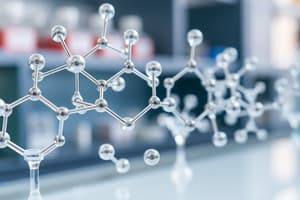Podcast
Questions and Answers
What type of compounds typically include metals, metalloids, salts, and minerals used in drug formulations?
What type of compounds typically include metals, metalloids, salts, and minerals used in drug formulations?
- Inorganic Compounds (correct)
- Biological Compounds
- Organic Compounds
- Synthetic Compounds
Which of the following is an example of a metal-based drug used in cancer treatment?
Which of the following is an example of a metal-based drug used in cancer treatment?
- Aspirin
- Ibuprofen
- Penicillin
- Cisplatin (correct)
What technique is used to analyze crystal structures in pharmaceutical inorganic chemistry?
What technique is used to analyze crystal structures in pharmaceutical inorganic chemistry?
- Mass Spectrometry
- Infrared Spectroscopy
- Nuclear Magnetic Resonance
- X-ray Diffraction (correct)
Which of the following agents is known for its antibacterial properties?
Which of the following agents is known for its antibacterial properties?
What are strictly regulated by health authorities to ensure the safety and efficacy of inorganic pharmaceutical agents?
What are strictly regulated by health authorities to ensure the safety and efficacy of inorganic pharmaceutical agents?
Study Notes
Overview of Pharmaceutical Inorganic Chemistry
- Focuses on inorganic compounds and materials used in pharmaceutical applications.
- Integrates principles of chemistry, biology, and medicine.
Key Concepts
- Inorganic Compounds: Typically include metals, metalloids, salts, and minerals used in drug formulations.
- Metal-based Drugs: Include compounds containing metals like platinum, gold, and silver; used in cancer treatment and antimicrobial therapies.
Applications
-
Therapeutic Agents:
- Heavy Metals: e.g., Cisplatin (platinum-based anticancer drug).
- Complexes: e.g., Iron supplements (ferrous sulfate).
-
Diagnostic Agents:
- Radioactive isotopes: Used in imaging (e.g., Technetium-99m in SPECT scans).
-
Antimicrobial Agents:
- Silver compounds: Known for their antibacterial properties (e.g., silver sulfadiazine).
-
Antidotes:
- Chelating agents: e.g., EDTA for lead poisoning.
Characterization Techniques
- X-ray Diffraction (XRD): Analyzes crystal structures.
- Infrared Spectroscopy (IR): Identifies functional groups.
- Nuclear Magnetic Resonance (NMR): Studies the magnetic properties of atomic nuclei.
- Mass Spectrometry: Determines molecular weights and structures.
Safety and Toxicology
- Understanding the toxicity of inorganic compounds is crucial.
- Heavy metals and compounds must be handled with caution due to potential health risks.
Regulatory Considerations
- Strict guidelines by health authorities (e.g., FDA) govern the development and use of inorganic pharmaceutical agents.
- Quality control measures are essential for ensuring safety and efficacy.
Future Directions
- Development of novel metal-containing drugs.
- Research on nanomaterials for drug delivery and targeted therapies.
- Exploration of bioinorganic compounds for therapeutic applications.
Overview of Pharmaceutical Inorganic Chemistry
- Examines inorganic compounds and materials utilized in pharmaceuticals.
- Merges principles from chemistry, biology, and medicine for comprehensive drug development.
Key Concepts
- Inorganic Compounds: Encompass metals, metalloids, salts, and minerals vital for drug formulation.
- Metal-based Drugs: Includes metal-containing compounds like platinum, gold, and silver; crucial in treating cancer and infections.
Applications
- Therapeutic Agents:
- Heavy Metals example: Cisplatin, a platinum-based medication for cancer.
- Complexes like ferrous sulfate for iron supplementation.
- Diagnostic Agents:
- Radioactive isotopes, such as Technetium-99m, essential in SPECT imaging.
- Antimicrobial Agents:
- Silver derivatives like silver sulfadiazine noted for effective antibacterial properties.
- Antidotes:
- Chelating agents, including EDTA, utilized to treat lead poisoning.
Characterization Techniques
- X-ray Diffraction (XRD): Critical for analyzing crystal structures of compounds.
- Infrared Spectroscopy (IR): Useful in identifying functional groups within complexes.
- Nuclear Magnetic Resonance (NMR): Explores magnetic properties of atomic nuclei, aiding in structure determination.
- Mass Spectrometry: Essential for ascertaining molecular weights and structural formulations of compounds.
Safety and Toxicology
- Assessment of toxicity in inorganic compounds is fundamental for safe usage.
- Caution required when handling heavy metals due to associated health risks.
Regulatory Considerations
- Health authorities like the FDA impose rigorous guidelines for the development of inorganic pharmaceutical agents.
- Quality control protocols are imperative to ensure the safety and effectiveness of these compounds.
Future Directions
- Focus on creating innovative metal-containing drugs for various treatments.
- Research efforts geared towards using nanomaterials for enhanced drug delivery systems and targeted therapies.
- Investigation into bioinorganic compounds for potential therapeutic use in medical applications.
Studying That Suits You
Use AI to generate personalized quizzes and flashcards to suit your learning preferences.
Description
This quiz covers the essentials of pharmaceutical inorganic chemistry, focusing on key inorganic compounds used in drug formulation and their applications in medicine. Explore the therapeutic, diagnostic, and antimicrobial uses of metal-based drugs, as well as various characterization techniques.




